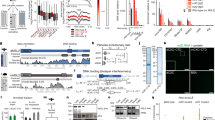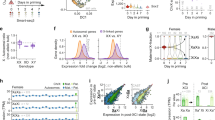Abstract
The X and Y chromosomes that maintain human dimorphism are thought to have descended from a single progenitor, with the Y chromosome becoming largely depleted of genes1. A number of genes, however, retain copies on both X and Y chromosomes and escape the inactivation that affects most X-linked genes in somatic cells2. Many of those genes are present in two pseudoautosomal regions (PARs) at the termini of the short (p)3 and long (q)4,5 arms of the sex chromosomes. For both PARs, pairing facilitates the .exchange of information, ensuring the homogeni-sation of X and Y chromosomal material in these regions6–10. We report here a strikingly different regulation of expression of a gene in Xq PAR. Unlike all Xp PAR genes studied so far, a synaptobrevin-like gene, tentatively named SYBL1, undergoes X inactivation. In addition, it is also inactive on the Y chromosome, thereby maintaining dosage compensation in an unprecedented way.
This is a preview of subscription content, access via your institution
Access options
Subscribe to this journal
Receive 12 print issues and online access
$209.00 per year
only $17.42 per issue
Buy this article
- Purchase on Springer Link
- Instant access to full article PDF
Prices may be subject to local taxes which are calculated during checkout
Similar content being viewed by others
References
Graves, J.A.M. The origin and the function of the mammalian Y chromosome and Y-borne genes-an evolving understanding. BioEssays 17, 311–321 (1995).
Lyon, M.F., The William allan Memorial Award address: X chromosome inactivation and the location and expression of X linked genes. Am J. Hum. Genet. 42, 8–16 (1988).
Rappold, G.A. The pseudoautosomal region of the human sex chromosomes. Hum. Genet. 92, 315–324 (1993).
Freije, D. & Schlessinger, D. A 1.6 Mb contig of Yeast Artificial Chromosome around the human Factor VIII reveals three regions homologous to probes for DXS115 and two for the DXYS64 locus. Am. J. Hum. Genet. 51, 66–80 (1992).
Freije, D., Helms, C., Watson, M.S. & Donis-Keller, H. Identification of a second pseudoautosomal region near the Xq and Yq telomeres. Science 258, 1784–1787 (1992).
Rouyer, F. et al. A gradient of sex linkage in the pseudoautosomal region of the human sex chromosomes. Nature 319, 291–295 (1987).
Chandley, A.C., Goetz, P., Hargreave, T.B., Joseph, A.M. & Speed, R.M. On the nature and the extent of XY pairing at meiotic prophase in man. Cytogenet Cell. Genet. 38, 241 (1984).
Mohandas, T.K. et al. Role of the pseudoautosomal region in sex chromosome pairing during male meiosis: meiotic studies in a man with a deletion of distal Xp. Am. J. Hum. Genet. 51, 526–533 (1992).
Kvaloy, K., Galvagni, F. & Brown, W.R.A. The sequence organization of the long arm pseudoautosomal region of the human sex chromosomes. Hum. Mol. Genet. 3, 771–778 (1994).
Li, L. & Hamer, D.H. Recombination and allelic association in the Xq/Yq homology region. Hum. Mol. Genet. 4, 2013–2016 (1995).
Kozak, M. Comparison of initiation of protein synthesis in procaryotes, eucaryotes and organelles. Microbiol. Rev. 47 1–45 (1983).
Cooke, H.J., Brown, W.A.R. & Rappold, G.A. Closely related sequences on human X and Y chromosomes outside the pairing region. Nature 311, 259–261 (1984).
Palmieri, G. et al. YAC contig organization and CpG analysis in Xq28. Genomics 24, 149–158 (1994).
Kutay, U., Ahnert-Hilger, G., Hartmann, E., Wiedenmann, B. & Rapoport, T.A. Transport route for synaptobrevin via a novel pathway of insertion into the endoplasmic reticulum membrane. EMBO J. 14, 217–223 (1995).
Protopopov, V., Govindan, B., Novick, P. & Gerst, J.E. Homologs of the synaptobrevin/vamp family of synaptic vesicle proteins function on the late secretory pathway in S. cerevisiae. Cell 74, 855–861 (1995).
Brown, C.J. et al. A gene from the region of the human X inactivation centre is expressed exclusively from the inactive X chromosome. Nature 349, 38–44 (1991).
Goodfellow, P.J., Darling, S.M., Thomas, N.S. & Goodfellow, P.N. A pseudoautosomal gene in man. Science 234, 740–743 (1986).
Brown, C.J., Flenniken, A.M., Williams, B.R.G. & Willard, H.F. X chromosome inactivation of the human TIMP gene. Nucl. Acids Res. 18, 4191–4195 (1990).
Bickmore, W.A. & Cooke, H.J. Evolution of homologous sequences on the X and Y chromosomes, outside of the meiotic pairing segment. Nucl. Acids Res. 15, 6261–6271 (1987).
Incerti, B. et al. Kallman syndrome gene on the X and Y chromosomes: implications for evolutionary divergences of human sex chromosomes. Nature Genet. 2, 311–314 (1992).
Gottschling, D.E., Aparicio, O.M., Billington, B.L. & Zakian, V.A. Position effect at S. cerevisiae telomeres: reversible repression of Pol II transcription. Cell 63, 751–762 (1990).
Henikoff, S. Position effect variegation after 60 years. Trends Genet. 6, 422–426 (1990).
Hendrich, B.D. & Willard, H.F. Epigenetic regulation of gene expression:the effect of altered chromatin structure from yeast to mammals. Hum. Mol. Genet 4, 1765–1777 (1995).
Cattanach, B.M. Position effect variegation in the mouse. Genet. Res. 23, 291–306 (1974).
Kermouni, A. et al. The IL-9 receptor gene (IL-9R): Genomic structure, chromosomal localization in the pseudoautosomal region of the long arm of the sex chromosomes, and identification of IL-9R pseudogenes at 9qter, 10pter, 16pterand 18 pter. Genomics 29, 371–382 (1995).
Hamer, D.H., Hu, S., Magnuson, V.L., Hu, N. & Pattatucci, A.M. A linkage between DMA markers on the X chromosome and male sexual orientation. Science 261, 321–327 (1992).
Grausz, J.D. & Auffray, C. Strategies in cDNA programs. Genomics 17, 530–532 (1993).
D'Esposito, M. et al. PCR-based immortalization and screening of hierarchical pools of cDNAs. Nucl. Acids. Res. 22, 4806–4809 (1994).
Skowronski, J., Fanning, T.G. & Singer, M.F., Unit-length Line-1 transcripts in human teratocarcinoma cells. Mol. Cell. Biol. 8, 1385–1397 (1988).
Melton, DA. et al. Efficient in vitro synthesis of biologically active RNA and RNA hybridization probes from plasmids containing bacteriophage SP6 promoter. Nucl. Acids Res. 12, 7035–7056 (1984).
Author information
Authors and Affiliations
Corresponding author
Rights and permissions
About this article
Cite this article
D'Esposito, M., Ciccodicola, A., Gianfrancesco, F. et al. A synaptobrevin–like gene in the Xq28 pseudoautosomal region undergoes X inactivation. Nat Genet 13, 227–229 (1996). https://doi.org/10.1038/ng0696-227
Received:
Accepted:
Issue Date:
DOI: https://doi.org/10.1038/ng0696-227
This article is cited by
-
DNA methylation signature in peripheral blood reveals distinct characteristics of human X chromosome numerical aberrations
Clinical Epigenetics (2015)
-
Analysis of expressed SNPs identifies variable extents of expression from the human inactive X chromosome
Genome Biology (2013)
-
Alternative splicing of the human gene SYBL1 modulates protein domain architecture of longin VAMP7/TI-VAMP, showing both non-SNARE and synaptobrevin-like isoforms
BMC Molecular Biology (2011)
-
Replication profile of PCDH11X and PCDH11Y, a gene pair located in the non-pseudoautosomal homologous region Xq21.3/Yp11.2
Chromosome Research (2007)
-
Vamp7
AfCS-Nature Molecule Pages (2006)



